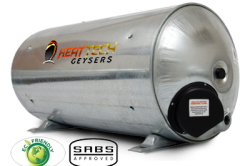Hi-Tec Plumbing supplies and install new geysers and replaces burst geysers.
Sacrificial anodes in Geysers are THE key component influencing the life expectancy of your geyser. Hi-Tec Plumbing maintains geysers ensuring a long life for your geyser.
Cylinder Failure
 A geyser will fail completely due to a manufacturing fault, corrosion and rust. All geysers will corrode and will eventually fail to work at all. To reduce corrosion, an anode is supplied with your geyser that essentially “sacrifices” itself to limit the corrosion of the cylinder.
A geyser will fail completely due to a manufacturing fault, corrosion and rust. All geysers will corrode and will eventually fail to work at all. To reduce corrosion, an anode is supplied with your geyser that essentially “sacrifices” itself to limit the corrosion of the cylinder.
Your geyser’s anode needs to be replaced from time to time as it has a limited life and needs to be checked and replaced when depleted – we suggest this be done at least every year or maximum every 2 years. It is the single most important component that will affect the lifespan of your hot water cylinder.
How an anode works
A geyser cylinder is filled with water and together with an electrical current; it will be subjected to an electrolytic process called electrolysis. When two metals are connected in water, one will corrode away sacrificing itself. The less reactive metal will not corrode. The anode is usually manufactured from magnesium, a “less noble metal”, than Steel from which the tank is manufactured.
New and corroded anode
The life of the anode rod is determined by various factors such as the quality of the water and the minerals contained in the water, the use of hot water and the temperature setting and the hardness of the water all affect its life. Once removed the rod will appear rough. Magnesium is formed around a steel core which will become exposed as the magnesium corrodes. If no magnesium is present your cylinder has started corroding. A rod showing no or very little corrosion may have become “passivated” and is not preventing the steel cylinder from corroding. Don’t take a chance. Replace it!
Sediment
The corroding anode leads to the formation of magnesium sulphate which settles at the bottom of the cylinder. Also formed as sediment that looks like sand is calcium carbonate that precipitates out of the water at high temperature. This can sometimes form into little rocks. The little filter on a tap or leading into a toilet cistern often becomes blocked by this “sand.” So does a shower head.
Hot water cylinders should be serviced annually, something which seldom occurs. Leaks and corrosion becomes evident and the cylinder should be drained and flushed to remove sediment.
ENERGY EFFICIENT GEYSERS
Replace that old geyser with a more energy efficient geyser – the latest geyser on the market is the Heat Tech Geyser which is tried and tested and an exceptional product. The Inner Cylinder is manufactured from 2mm Steel as opposed to the 1.6mm Steel used by their competitors. The Heat Tech products are designed by Stuart Thompson who designed the first Dual geyser for Kwikot in the 1980s. They are also the only geyser manufacturer to commercially use Eco Friendly Polyurethane Foam The geysers carry the industry standard guarantees i.e. five (5) years on the Cylinder, two (2) years on the Valves and one (1) year on the Electrical (element and thermostat).
